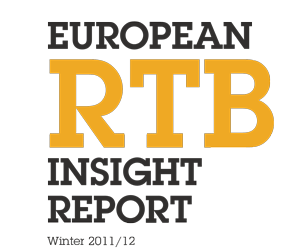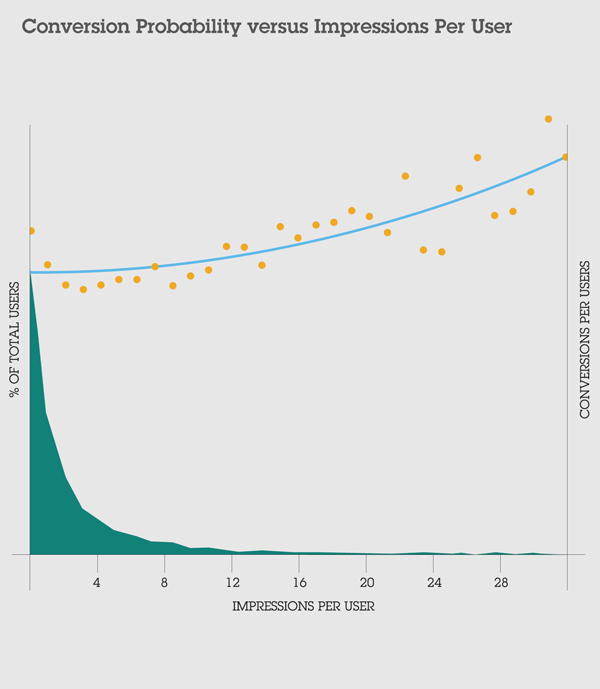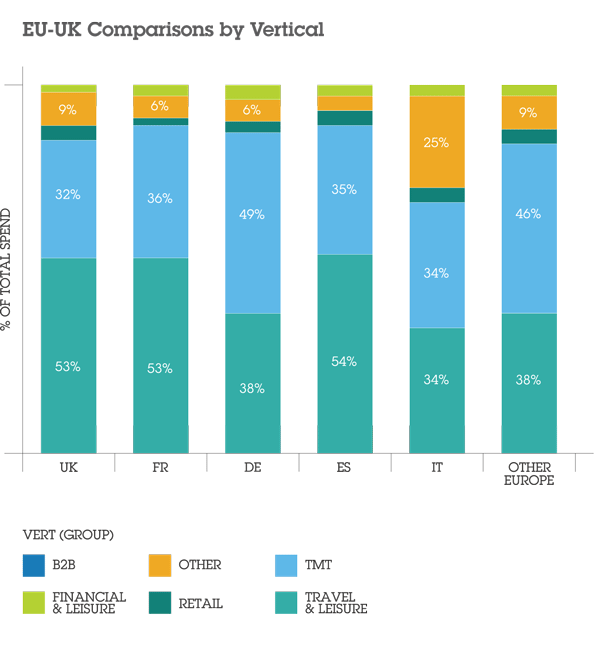Euro Data-Driven Display In Focus: Infectious Media Releases Its RTB Insight Report, Winter 2011/12
by Ciaran O'Kane on 5th Apr 2012 in News

Infectious Media released its RTB Insight Report for the Winter period 2011/12 (December, January and February), providing an overview on buying and pricing trends across the European exchange eco-system. The report's findings are put together using aggregated and anonymised campaign data from its proprietary technology, Impression Desk. The findings, whilst specific to Infectious Media, represent work carried out for clients spanning all industry sectors with differing objectives, budgets and target audiences, which may be indicative of industry wide trends.
The key findings of the latest report include:
- CPM inflation is good news for publishers
- Competition in the UK is driving CPM and CPC above European rates
- The majority of categorised impressions served appear above the fold
- CPM of below the fold impressions is disproportionately high
- Ad distribution by verticals is similar across Europe
- Discrepancies in B2B CTRs a consequence of market maturity
- Fluctuations in CPC and CPM cannot be attributed to supply and
demand alone
Andy Cocker, Co-Founder and Managing Partner Infectious Media, shares his observations:
“Those of us who live and breathe real-time advertising know this is an industry that operates at breakneck speed, and over the last few months alone, we have seen major developments on the supply side in key European markets bringing an influx of quality premium publisher inventory to market. The UK has also seen several big name publishers entering the market via private exchanges, which is great news for advertisers as the volume and quality of inventory continues to improve.
“This year the UK IAB hosts its first Real-Time Advertising event to an audience expected to be dominated by brands; DMexco estimates it will attract over 20,000 visitors; and ExchangeWire’s ATS events will run across two continents."
Addressing Ad Burnout
Harley Norrgren, Principal Analyst at Infectious Media, delves into the prickly question of ad burnout to see if RTB can answer the age old issue of how long you should ideally show a user your ad.
“We have taken users from a sample of +200 separate advertising campaigns during the month of February 2012 and split them out by preceding impression frequency. Dividing the number of conversions by the number of users at each interval provides us with the probability of conversion given a particular number of impressions. By excluding users who saw only one impression, we aimed to circumvent bias introduced by cookie deletion.
“Display advertising has a positive effect on conversion rates: we see that purchasing behaviour is correlated at the user level, and fairly strongly, with volume of adverts they’ve seen. Without the presence of a local maximum in this model, it’s hard to be specific about the number of impressions required it to illicit a conversion; we can infer however that given the distribution of users and the positive marginal effect of an ad view, that a relaxed approach to frequency capping would not necessarily impact negatively on the performance of a campaign.

“Rather, given that over a one-month period the majority of users saw fewer than four adverts on average per campaign, the requirement for frequency capping seems a little overstated when looking at the data as a whole.”
CPMs On The Rise
As one of the more mature European markets in terms of RTB; Germany has seen stable growth in CPMs over Winter 2011/12. Although still stable, growth in CPCs has been faster, which indicates CTRs are dropping overall and in line with expectations from a more mature market. Typically for this period, there are large peaks in December as pre-Christmas campaigns go live, together with higher CPCs post-Christmas as fewer people click.
Western European markets exploded with CPMs up by 46% in Sweden, 71% in Norway and 126% in Ireland, 129% in Spain and 134% in Italy. The UK was relatively stable, increasing CPMs by only 2% in the same period. Central European growth has shifted the CPM divide from a north-west/south-east to a much more east-west position and signifies an increase of inventory being made available through RTB selling by publishers across the region.
The maturing of Western Europe is great news for publishers and advertisers alike as higher CPMs should result in more publishers releasing more inventory into the exchanges, thereby creating new opportunities for advertisers to reach their target audiences via RTB. In contrast to Western Europe, Eastern Europe remains much more stable, achieving on average 35% lower CPMs than Western Europe.
CPMs for the region have grown steadily. CPMs in the UK were stable during this period, with slight growth across Europe as a whole. The trend for CTRs across Europe is upwards, with noted volatility around December where click patterns are disturbed by a trend towards more direct response based advertising in the Christmas and post-Christmas seasons. In the UK, 2012 came in with a bang, with CTRs very strong in January and February, coinciding with the release of additional inventory onto the exchange from some premium publishers; whether this is a spike rather than a trend will be seen as the year unfolds.
European Publishers Masking Inventory Position On Page
Overall, this season has seen publishers increasingly masking inventory position across the whole region. The trend is most dramatic in countries like Belarus, Bulgaria and Ukraine, where masked positions have shifted from accounting for around 50% to now over 95% of all impressions available. Changes have been less significant in Western Europe, with countries including the UK, Germany and the Netherlands seeing the proportion of all placements virtually unchanged since the previous quarter. Denmark, Spain and Turkey go against much of Europe by showing a decrease in the number of masked impressions over the same period, but overall much of Western Europe and most of Eastern Europe has experienced a shift towards masking fold positions this quarter.
Masking inventory could be a strategic decision on behalf of the publishers, or simply due to tactical implementation issues. Whether this trend changes in the longer term will depend upon the value advertisers place upon this particular data point as opposed to the increasing amount of 3rd party data points available on the market; it remains to be seen whether the use of exposure-time data, for which fold position is assumed to be a proxy, or the last-event attribution model which renders the ad view virtually redundant, will contribute towards a devaluation of fold position data and ultimately lead to the lack of classification from sellers.
As with last season, travel and leisure domains dominate across the region with the notable exceptions of Germany and Italy. The German market continues to be heavily focused on inventory within the Telecommunications, Media and Technology (TMT) sector.
In an overall picture of stability only Italy has seen significant change, with spend moving out of travel and leisure and into “other”. Looking more closely, this spend has been particularly focused on webmail, opening up the possibility of higher-performing brand advertising for advertisers in Italy given the influx of high visibility placements.
The Breakdown In Vertical Spend
Spend on retail sites remains low. It is largest in the UK, where it still only accounts for 7% of all ad impressions. This trend is unlikely to change as the competitiveness of the retail market necessitates that publishers don’t release significant amounts of inventory onto the exchanges.

Andy Cocker comments: “In the UK, May brings with it legislative requirements around the ePrivacy Directive and this is an issue likely to bubble across Europe throughout the year. The year is already set to be an exceptional one in the history of RTB and real-time advertising, with budget share predictions ranging from 10% to 20% of all online display spend. But, if the industry is to realise this potential, it is incumbent upon us to ensure the reality of RTB lives up to the promise. Making that happen needs all the real-time pieces to come together, be that bespoke algorithms, dynamic creatives or sophisticated data analytics taking in 1st as well as 3rd party data.”
DACHDisplayEMEANordicsProgrammaticPublisherTrading








Follow ExchangeWire